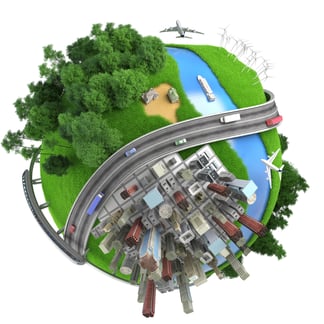
How is your company and fleet affecting the environment and how can you help!
It is estimated that over a billion people participate in Earth Day every year, making it the largest secular observance in the world. The first Earth Day was celebrated on April 22, 1970. It sparked an environmental movement that led to the creation of the National Oceanic and Atmospheric Administration (NOAA) and the U.S. Environmental Protection Agency (EPA) later that year. Earth Day was also influential in passing environmental legislation like the Clean Air Act, Clean Water Act, Endangered Species Act, National Environmental Education Act, and more.
What does it mean to create a more “Eco Friendly” fleet? Companies with ESG goals and Emissions at the forefront maintain their fleet’s average life at about 3-4 years, allowing companies to reduce their carbon footprint, improve overall safety and driver morale and operate at a lower cost per mile. They can accomplish this by choosing a partner that can help with a Fleet Modernization Study with Emissions Scorecard, which reviews the entire fleet by year, make, model, and compares fuel and mileage data. It also provides detailed information on CO2 reduction in metric tons and gallons of fuel saved, each time the truck was replaced, as well as forecasted savings while helping companies complement their ESG strategies and goals to report to regulators and critical stakeholders.
What is ESG and how does it relate to your fleet? Environmental, Social, and Governance are values that all businesses are embracing. Entering the new millennium, few companies across all industries had a watchful eye toward environmental stewardship, particularly throughout the heavy-duty truck transportation industries. However, just a few short years later, governments in many countries began to better understand the benefits that could come from corporations curbing their carbon emissions output. New greenhouse gas mandates began to take effect by the early 2000s. Environmental, Social, and Corporate Governance evaluate a firm’s collective conscientiousness of social and environmental factors.

How to create an overall company ESG Strategy
Corporations and government leaders are facing tremendous pressure from key stakeholders, environmental groups, customers, and shareholders to develop a long-term ESG strategy. Forbes Magazine has outlined seven ways organizations of all sizes can leverage existing strengths when building their ESG programs.
- Appoint A Team—And an ESG Leader—To Align With ESG Guidelines
- Establish An Inventory of Existing ESG-Related Policies
- Assess Which ESG Targets Might Give a Competitive Advantage
- Identify Gaps in Performance and Score Easy Wins
- Centralize Data Collection With ESG-Friendly Software
- Gather ESG Data From Partners to Lay the Groundwork For Tackling Supply Chain Impact
- Regularly Review and Update ESG Commitments
How to create an ESG Strategy for your Fleet - At the heart of an ESG-centric strategy is an industry-best data analytics focus that relies on real-time business intelligence to help steer clients towards more environmentally sound business decisions. Companies with transportation fleets are starting to change the way they see the environment and their impact, and having the right partner in place to help you execute these goals is a key factor.
 For Environmental Criteria, focus on a continuous reduction in emissions and fuel consumption through shortening asset life cycles. Optimize vehicle specifications to be more fuel-efficient and align with the duty cycle and your geographical locale.
For Environmental Criteria, focus on a continuous reduction in emissions and fuel consumption through shortening asset life cycles. Optimize vehicle specifications to be more fuel-efficient and align with the duty cycle and your geographical locale.- For Social Criteria, focus on operating the newest and safest trucks, which will keep all motorists safe and help attract and retain a greater pool of diverse drivers and other staff. A more diverse approach to the transportation industry unlocks more potential growth for organizations through the advancement and empowerment of a gender-diverse workforce.
- For Governance, ensure you can provide analytics, processes, and transparency for your assets so that you can meet legal requirements and satisfy every stakeholder in the process. This also includes the new certified Greenhouse Gas Emissions (GHG) output, recently mandated under a proposed rule issued by the Securities and Exchange Commission (SEC). On March 21, the SEC issued a proposed rule designed to enhance and standardize climate-related disclosures divulged by public companies. Under the proposal, a registrant is required to adhere to greenhouse gas (GHG) emissions disclosures within qualitative governance disclosures within their annual reports (e.g., Form 10-K). Comments on the proposed rule are due 30 days after its publication in the Federal Register or May 20, 2022.
Looking Ahead - Companies today are proud of the cultures they have created internally. Many are strong examples of how diversity and inclusion in the workplace can positively impact an organization, its employees, customers, and surrounding communities. When evaluating your ESG goals with an internal team or outside partner, strive to create a culture of diversity and to become sustainable, socially conscious, and governed with as much integrity as possible.
To learn more or receive an Emissions Scorecard visit https://www.fleetadvantage.com/contact.






